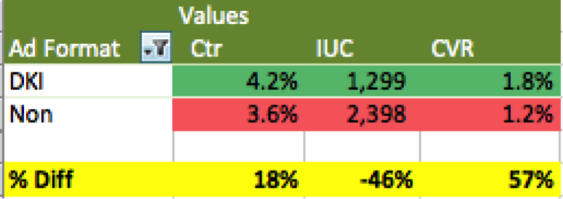Ad creative is the talk of the PPC town. Especially with the release of Expanded Text Ads in AdWords and Bing, it just goes to show you that ads are one of, if not “the”, most important areas to make an impact on your PPC performance.
One oldie but goodie type of ad creative that has stood the test of time for improving ad to keyword relevancy is Dynamic Keyword Insertion Ads – DKI. Yes folks, I’m bringing back 2009 DKIs!
Since 2009, more dynamic ad formats have been rolled out, however, I plan to cover how using one of my old school favorites – DKI – helped not only improve CTR but how it also helped improve many other key metrics including:
- Impression share
- Impression until conversions
- Lower cost-per-clicks
Let’s Get Dynamic – Ads, Ads, And More Ads
As mentioned above, there are MANY new dynamic ad features available that have evolved since the roll out of the original Dynamic Keyword Insertion ads. These formats include Dynamic Search Ads (DSAs) and Ad customizers.The reason there are so many new ad formats is because they work! Trust me, take it from the Ad guru himself
The reason there are so many new ad formats is because they work! Trust me and take it from the Ad guru himself, Matt Umbro. Anytime you can create a better user experience by aligning the most relevant keyword to ad to landing page, you’re going to see better results.
The best part about dynamic ad formats is that they actually save time by allowing you to create one dynamic ad format using parameters. You are then able to create a very specific user experience. Anytime I can save time and see better results – count me in!
Below, we will cover how old school Dynamic Keyword Insertion ads impacted not only CTR but several other key metrics in an account.
The Situation – Increased Lost Impression Share Due To Rank And Rising CPCs
For this particular account, we were seeing an increase in the dreaded Impression Share Lost to Rank. Unlike Impression Share Lost to Budget, this metric is a little more of a complicated fix (or so I thought) to work on improving impression share. You can potentially create single keyword ad groups (SKAGS) to help. Or just create specific ads for each ad group, but ain’t nobody got time for that! So I decided to resort back to testing an old favorite in the ad testing cycles.
The Set-Up – DKI {KeyWord:} In Ad Headline vs. Winning Control Ad
For this particular test, we only used DKI in the headline. However, I’ve seen DKI be successful in description lines and display URLs as well. To keep a clean testing environment we left description lines, display, and final URLs the same as the control ads.
We rolled this update out to campaigns where we were seeing the largest drop in impression share and the keyword sets were in a logical format. For example “PPC Conferences in London”.
To avoid ads that didn’t make sense we made sure to exclude ad groups from the test that included competitor terms, misspellings, and weird broad keyword strings.
The Results – Impression Share Increased by 36% In 3 Months.
Our main goal for the test was to try and optimize impression share while also trying to reduce our rising CPCs by improving quality score. We were successful! However, the success didn’t stop there as we saw improvements in almost all key metrics including:
- Total impression share – up 36%
- Impression share lost to rank – down 34%
- Average cost per click – down 20%
- Click through rates – up 18%
- Impressions until conversions – down 46%
- Conversion rates – up 57%

DKI ad KPI performance month over montNon-DKI

Hypothesis For Success Using DKI – Increased Relevancy
After running the ad test for almost 60 days we were able to call the DKI ads a winner compared to the previous winning control ad. While we expected higher CTRs, the dramatic increase in impression share was something that took us by surprise.
What we can determine was that by including DKI in the headline, we were able to show a more relevant ad to our users. This helped increase ad relevancy factors in quality scores, which helped improve our overall ad rank allowing the ads to enter more auctions.
While we saw success with DKI ads for this test, there are also instances when DKI ads do not make sense and can actually do more damage than good. Below are the benefits and when to avoid using DKI.
DKI Benefits
- Higher CTRs & CVR
- More ad relevancy
- Higher quality scores
- Increased impression share
Avoid Using DKI Ads For
- Competitor keywords
- Misspellings
- Generic & broad keywords
- Strange keyword orders
Closing Thoughts
DKI Ads worked great and helped us achieve the goal we were hoping for by improving impression share lost to rank and reducing CPCs. While the result was great, there are many newer dynamic ad options available that can allow you to get even more granular with the relevancy you are able to provide to users. Whatever dynamic ad format you decide works best for your account is up to you, just be sure to always be testing and continually be working to provide the most relevant user experience and you will see success in the long run.



